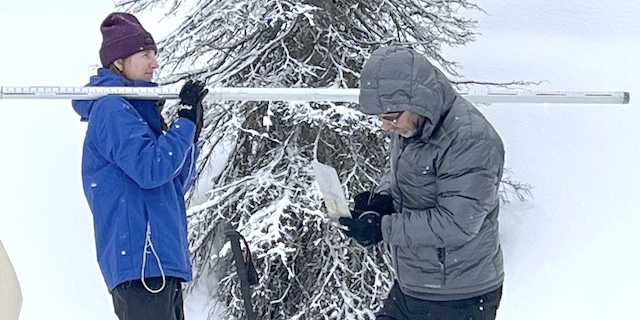Idaho water supply forecasters optimistic after wet March
Published 11:34 am Tuesday, April 8, 2025

- NRCS water supply specialist Erin Whorton and acting supervisory hydrologist Shawn Nield take snow core measurements April 1 in the mountains northeast of Boise. (Courtesy NRCS)
Snowpack that is near, at, or above normal in much of Idaho leaves USDA Natural Resources Conservation Service hydrologists optimistic that many irrigators will have enough water.
The only areas of concern, where snowpack is below normal, are the Coeur d’Alene-St. Joe basin in the northern panhandle, the Big Lost and Little Lost basins in the central mountains and the Birch-Medicine Lodge/Beaver-Camas basin in the east-central region, according to the April 1 NRCS Idaho Water Supply Outlook Report.
“The near- to above-normal snowpack across many basins in Idaho bodes well for a good water supply season this water year,” Erin Whorton, NRCS Idaho water supply specialist, said in a news release. “Of course, what happens during the spring and summer will strongly influence whether there’s enough water to go around, but with this year’s snowpack and the expectation that reservoirs will fill, conditions are setting water users up for success.”
With recent warm weather, it appears snowpack has peaked, she said in an interview. At this point in the Oct. 1-Sept. 30 water year, “we do have a good sense of what the water season is going to look like” except for spring weather impacts.
Irrigators use natural-flow water rights before they exercise rights to water stored in reservoirs. Spring rain would reduce irrigation demand and in turn allow irrigators to delay usage of storage water, effectively making it available longer into the season, Whorton said. But if spring conditions are hot and dry, “natural flow might taper off sooner rather than later and irrigators would need to use their stored water.”
Streamflow and reservoir-storage forecasts “indicate that it will be a good water season across much of Idaho,” she said.
Upper Snake River Basin supply improved and looks good thanks to above-normal precipitation in February and March, Whorton said. “It looks like a good water season, but of course it will depend on spring weather.”
The National Oceanic and Atmospheric Administration’s Climate Prediction Center forecasts warmer-than normal conditions through mid-April, but the center’s one-month outlook is less certain, according to the NRCS report. In late spring and in summer, the center expects conditions that are warmer and drier than normal.
Drought conditions persist along the Idaho-Montana border, according to the U.S. Drought Monitor.
Reservoir storage volume was 95% of normal in the Boise River basin and 93% of normal in the Payette system April 1, according to NRCS. In both systems, releases from behind dams started in mid-March to reduce flood risk and make room for incoming snowmelt.
Upper Snake reservoir system storage was 116% of normal April 1, according to NRCS.
In the central mountains, Magic Reservoir volume was 90% of normal.
In Southern Snake River basins, where water-year precipitation is 100-120% of normal, reservoir volumes included 185% of normal in Owyhee, 137% in Oakley and 85% in Salmon Falls, according to NRCS.






